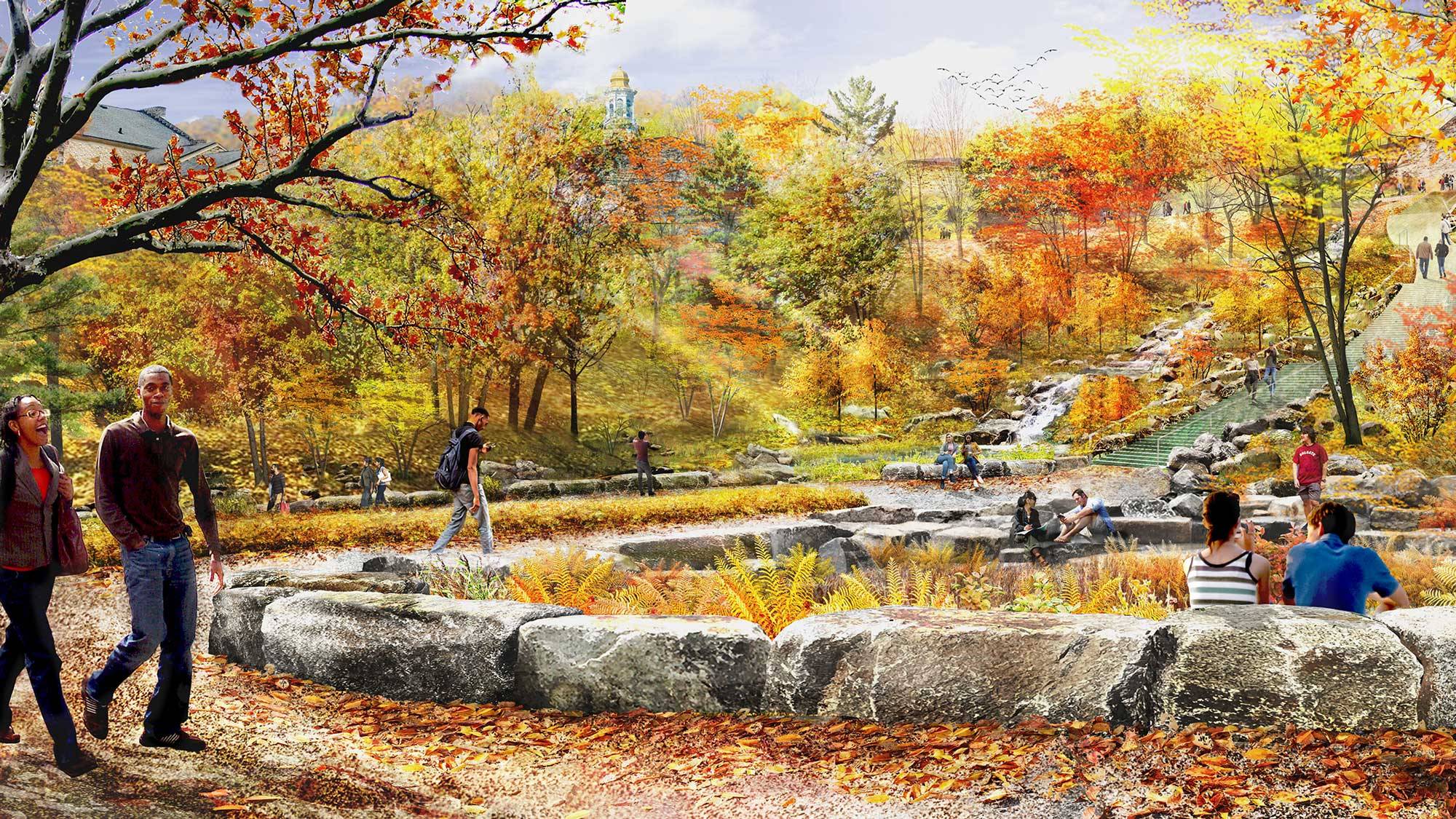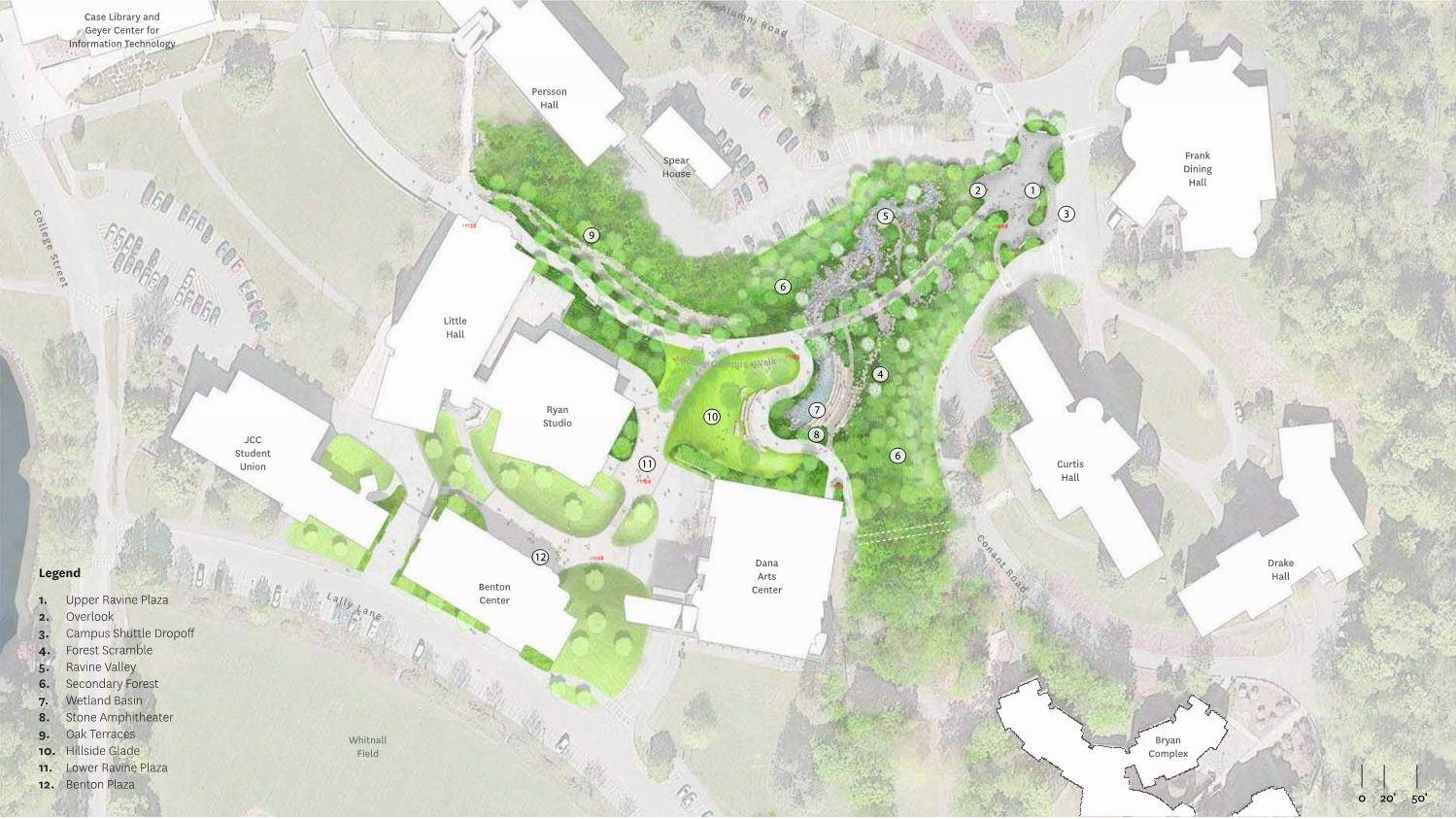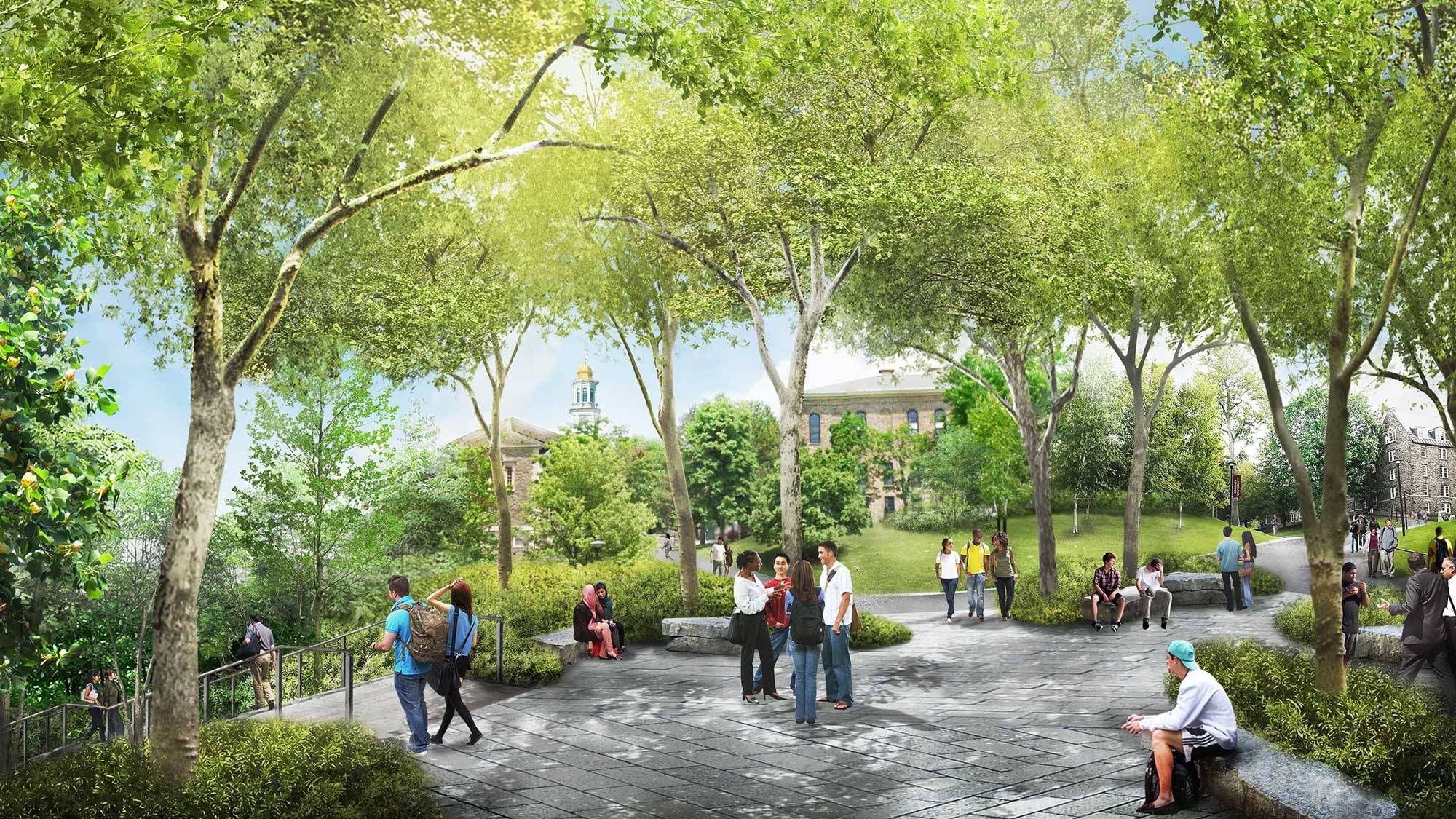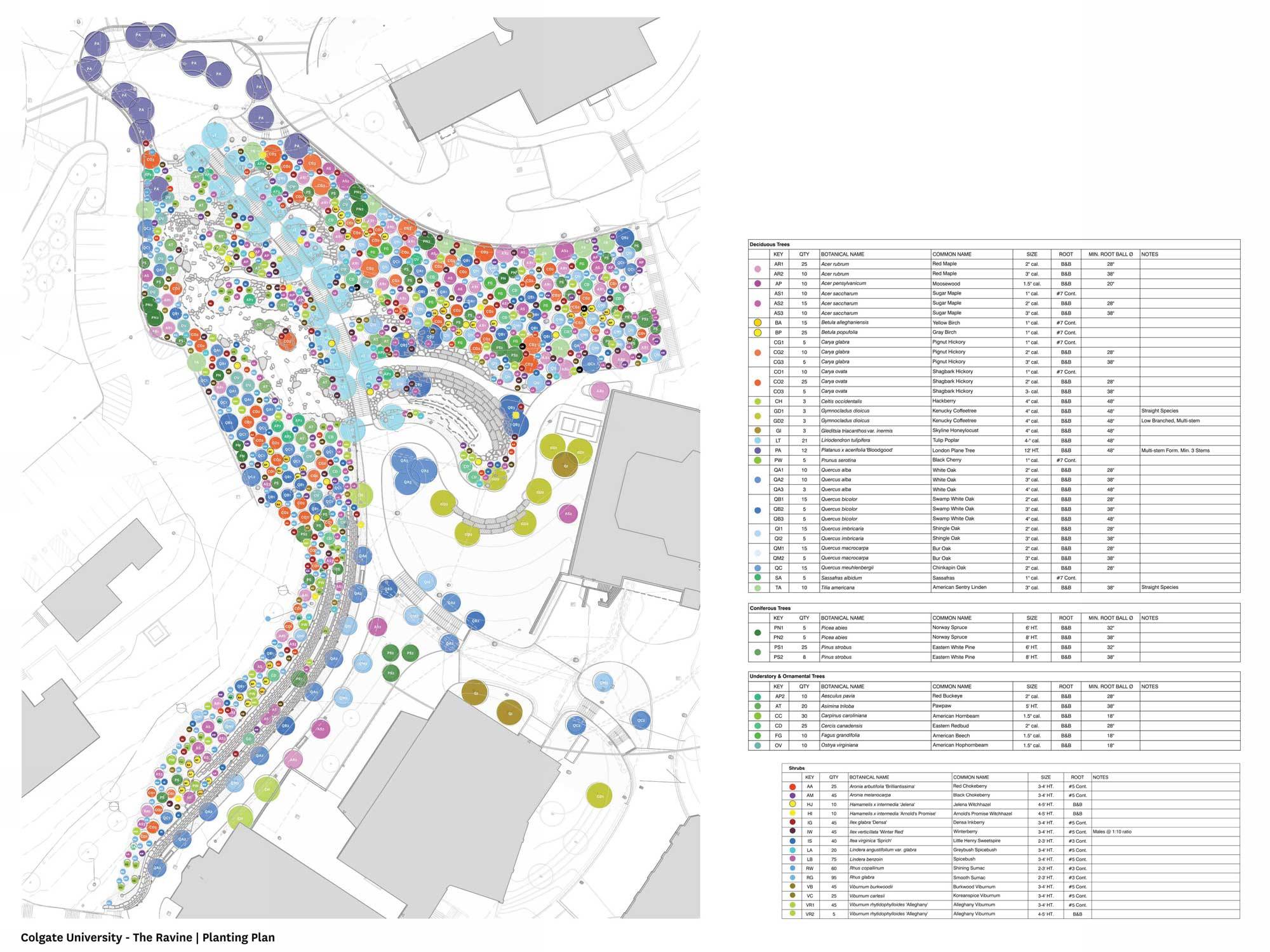Tiered pathway to connect middle and upper campus.
A major landscape and infrastructure project designed to better connect the upper and middle areas of campus at Colgate University will begin this month. This project will dramatically transform the wooded hillside area between Dana Arts Center and Frank Dining Hall, improve campus pedestrian circulation from Case-Geyer Library to Dana, and create a new plaza on the upper campus.
The project has been made possible thanks to the generous support of Peter L. Kellner ’65, P’87, GP’16,’19, who has previously supported several other critical elements of the Third-Century Plan, including the funding of two newly endowed faculty chairs, and contributions to the Colgate Commitment financial aid initiative. The reimagined and rebuilt hillside will be named Peter’s Glen in his honor.
Acclaimed landscape architects at Michael Van Valkenburgh Associates (MVVA) are responsible for the Glen’s landscape design. MVVA is renowned for prominent design projects including Brooklyn Bridge Park, Harvard Yard, and the grounds of the presidential libraries of Presidents George W. Bush and Barack Obama. Construction is slated for completion in 2025.
The existing hillside will be transformed into a native landscape where water will cascade over natural stone into stepped pools alongside new pathways. There will be new spaces for gathering and a completely redesigned upper-campus plaza next to Frank Dining Hall that will drastically improve the pedestrian experience.
“The protection of Peter’s Glen will give us a chance to make a landscape type that you have in the surrounds of the campus, but not currently on the campus,” says MVVA Partner Michael Van Valkenburgh. “While the walk down Peter’s Glen allows long views into the valley, there also will be a sense — with the trees around you, as you go down the stairs — of being held there.”
“Given that this project will profoundly transform our campus for the next century, I knew we needed to collaborate with the world’s best landscape architects, and MVVA was our first choice,” said Colgate President Brian W. Casey. “I learned of Michael Van Valkenburgh during my own time at Harvard, when he led a complete restoration of Harvard Yard. I have followed his firm’s work as it has gained national and international acclaim. The professionals at MVVA are thoughtful, deeply creative, and environmentally conscious.”
MVVA has played a critical role in every major landscape project at Colgate since 2016, including the Burke-Pinchin quad and hillside, the Bicentennial Tree planting in the Academic Quad, the restoration of Oak Drive, and the design of the new pedestrian pathways at campus entrances.
This new project is an integral part of the Third-Century Plan commitment to responsibly steward the campus and its environs and is part of a series of recent improvements designed to connect the campus community through improved pedestrian circulation, up and down the hill. Kellner’s gift will also allow for improvements to the campus entrance at Oak Drive, complementing his prior support of new and expanded sidewalks, tree plantings, and Oak Drive restoration.
“I am pleased to be involved in several of the major initiatives of the Third-Century Plan. This initiative in particular will help to bolster Colgate’s commitment to environmental sustainability, while further enhancing the beauty of our campus. Colgate is fortunate to have Michael Van Valkenburgh and his great team involved in Colgate’s environmental master plan to enhance the walking experience on campus while also being ever mindful of our responsibility to be good stewards of a campus of remarkable beauty.”
Work Ahead
Initial site work in February will necessitate the clearing of hundreds of non-native and declining trees, shrubs, and overgrowth on the hillside to prepare for major excavation and earth moving. Currently, this unused area provides drainage for water flowing both from pipes and natural runoff and feeding an undersized storm system. Much of the surrounding vegetation is either invasive or susceptible to disease and pests. A redesigned and expanded storm-water system will control runoff water volume and reduce sedimentation.
The Glen will continue to evolve as planting of nearly 500 native trees and 500 native shrubs and plants takes place over several growing seasons. Heated stairs will create a path down the hill beside a cascading stream shaded by a natural tree canopy. Plazas at the top and bottom of the walkway will provide areas for relaxation, study, and gathering.
Improved Campus Entrances
In addition to the work on the Glen, Colgate’s main entrance on Oak Drive will be updated with new trees and plantings to complement the overall campus landscape vision and will create a clear connection to the walkway leading toward Peter’s Glen.
Glen Details
- New heated concrete stair system, pathways, and site lighting will connect the middle and upper campus through a wooded gully located between Ryan Studio/Dana Arts and the traffic circle below Frank Dining Hall.
- Stormwater runoff will be captured by a series of stone cascades and ephemeral pools during light rain events. A larger, closed conveyance system with capacity for heavy rain events will mitigate flooding and water quality issues.
- A lower stormwater basin will be an attractive landscape feature that will include stepped boulder seat walls.
- The Frank Dining Hall traffic circle will become a new upper plaza for improved pedestrian safety, ease of access, and a greater natural connection with the surrounding landscape. The plaza will feature stone pavers, boulder seat walls, new site lighting, and tree and understory plantings.
- A new lower plaza with pavers at the south side of Ryan Studio will connect the project to the new Benton Center, both physically and in shared materials.
- A portion of the project funds will provide the opportunity to bury unsightly utility lines along Broad Street in preparation for future construction plans on the lower campus.
- A new middle-campus pathway will create an accessible pedestrian spine from the back side of Little Hall to Dana Arts Center/Curtis stairs. Work includes the cutting back of the hillside behind Little Hall with a series of stone and oak terraces to open up views between Peter's Glen and points north towards Case Library.



